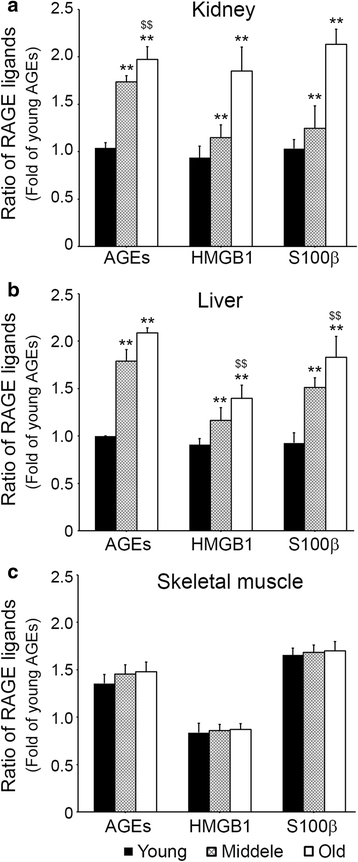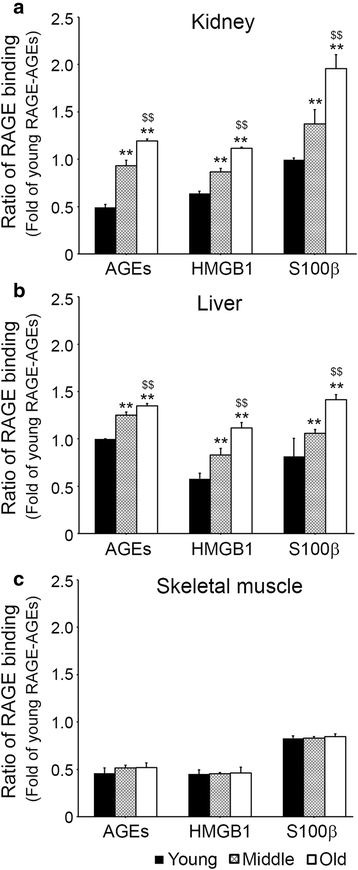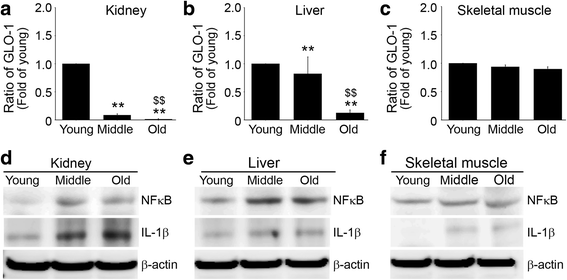Age dependent accumulation patterns of advanced glycation end product receptor (RAGE) ligands and binding intensities between RAGE and its ligands differ in the liver, kidney, and skeletal muscle
- PMID: 28592983
- PMCID: PMC5460364
- DOI: 10.1186/s12979-017-0095-2
Age dependent accumulation patterns of advanced glycation end product receptor (RAGE) ligands and binding intensities between RAGE and its ligands differ in the liver, kidney, and skeletal muscle
Abstract
Background: Much evidence indicates receptor for advanced glycation end products (RAGE) related inflammation play essential roles during aging. However, the majority of studies have focused on advanced glycation end products (AGEs) and not on other RAGE ligands. In the present study, the authors evaluated whether the accumulation of RAGE ligands and binding intensities between RAGE and its ligands differ in kidney, liver, and skeletal muscle during aging.
Results: In C57BL/6 N mice aged 12 weeks, 12 months, and 22 months, ligands accumulation, binding intensities between RAGE and its ligands, activated macrophage infiltration, M1/M2 macrophage expression, glyoxalase-1expression, and signal pathways related to inflammation were evaluated. The RAGE ligands age-associated accumulation patterns were found to be organ dependent. Binding intensities between RAGE and its ligands in kidney and liver increased with age, but those in skeletal muscle were unchanged. Infiltration of activated macrophages in kidney and liver increased with age, but infiltration in the skeletal muscle was unchanged. M1 expression increased and M2 and glyoxalase-1 expression decreased with age in kidney and liver, but their expressions in skeletal muscle were not changed.
Conclusion: These findings indicate patterns of RAGE ligands accumulation, RAGE/ligands binding intensities, or inflammation markers changes during aging are organs dependent.
Keywords: AGEs; Aging; Macrophage activation; RAGE; RAGE ligands.
Figures




Similar articles
-
Age-related accumulation of advanced glycation end-products-albumin, S100β, and the expressions of advanced glycation end product receptor differ in visceral and subcutaneous fat.Biochem Biophys Res Commun. 2016 Aug 19;477(2):271-6. doi: 10.1016/j.bbrc.2016.06.056. Epub 2016 Jun 11. Biochem Biophys Res Commun. 2016. PMID: 27301641
-
The attenuating effects of pyridoxamine on adipocyte hypertrophy and inflammation differ by adipocyte location.J Nutr Biochem. 2019 Oct;72:108173. doi: 10.1016/j.jnutbio.2019.04.001. Epub 2019 Apr 24. J Nutr Biochem. 2019. PMID: 31499381
-
Advanced glycation end product ligands for the receptor for advanced glycation end products: biochemical characterization and formation kinetics.Anal Biochem. 2004 Jan 1;324(1):68-78. doi: 10.1016/j.ab.2003.09.013. Anal Biochem. 2004. PMID: 14654047
-
The receptor for advanced glycation end-products (RAGE) is an important pattern recognition receptor (PRR) for inflammaging.Biogerontology. 2019 Jun;20(3):279-301. doi: 10.1007/s10522-019-09808-3. Epub 2019 Apr 9. Biogerontology. 2019. PMID: 30968282 Review.
-
RAGE Signaling in Skeletal Biology.Curr Osteoporos Rep. 2019 Feb;17(1):16-25. doi: 10.1007/s11914-019-00499-w. Curr Osteoporos Rep. 2019. PMID: 30685821 Free PMC article. Review.
Cited by
-
CaMKK2 Signaling in Metabolism and Skeletal Disease: a New Axis with Therapeutic Potential.Curr Osteoporos Rep. 2019 Aug;17(4):169-177. doi: 10.1007/s11914-019-00518-w. Curr Osteoporos Rep. 2019. PMID: 31115859 Free PMC article. Review.
-
Age-Influenced Receptors of Advanced Glycation End Product Overexpression Associated With Osteogenic Differentiation Impairment in Patients With Type 2 Diabetes.Front Endocrinol (Lausanne). 2021 Aug 26;12:726182. doi: 10.3389/fendo.2021.726182. eCollection 2021. Front Endocrinol (Lausanne). 2021. PMID: 34512554 Free PMC article.
-
AGEs and RAGE: metabolic and molecular signatures of the glycation-inflammation axis in malignant or metastatic cancers.Explor Target Antitumor Ther. 2023;4(5):812-849. doi: 10.37349/etat.2023.00170. Epub 2023 Sep 28. Explor Target Antitumor Ther. 2023. PMID: 37970208 Free PMC article. Review.
-
Dietary intake of advanced glycation endproducts and risk of hepatobiliary cancers: A multinational cohort study.Int J Cancer. 2021 Apr 25;149(4):854-64. doi: 10.1002/ijc.33612. Online ahead of print. Int J Cancer. 2021. PMID: 33899229 Free PMC article.
-
RAGE pathway activation and function in chronic kidney disease and COVID-19.Front Med (Lausanne). 2022 Aug 9;9:970423. doi: 10.3389/fmed.2022.970423. eCollection 2022. Front Med (Lausanne). 2022. PMID: 36017003 Free PMC article. Review.
References
-
- Schmidt AM, Vianna M, Gerlach M, et al. Isolation and characterization of two binding protein for advanced glycosylation end products from bovine lung which are present on the endothelial cell surface. J Biol Chem. 1992;267:14987–14997. - PubMed
-
- Neeper M, Schmidt AM, Brett J, et al. Cloning and expression of a cell surface receptor for advanced glycosylation end products of proteins. J Biol Chem. 1992;267:14998–15004. - PubMed
LinkOut - more resources
Full Text Sources
Other Literature Sources
Research Materials

